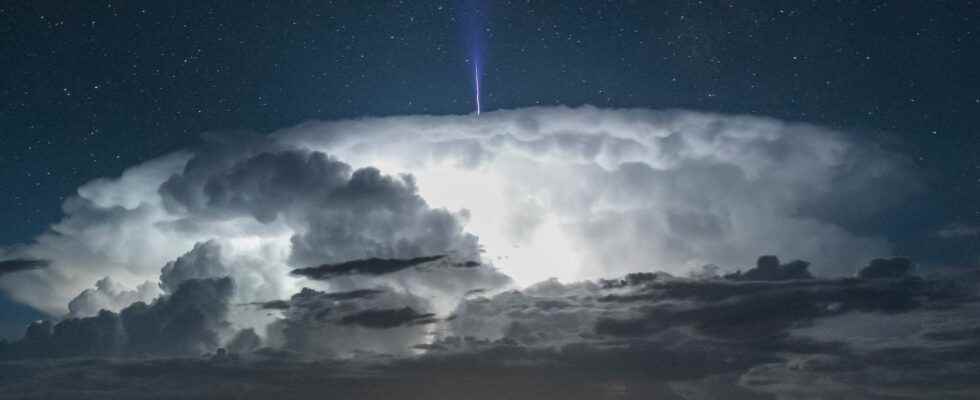You will also be interested
[EN VIDÉO] Discovering the hidden side of storms As spectacular as they are mysterious, sprites belong to the family of transient light phenomena (TLE).
During’thunderstorms violent, lightning sometimes goes upwards and comes to tickle theionosphere, nearly 80 kilometers above sea level. They are nicknamed the “blue jets”. In even rarer cases, these jets happen to be much more gigantic than the others. While they are particularly difficult to detect, in a study published in the journal Science Advances, researchers benefited from a stroke of fate and went so far as to map such an event! The electric shock occurred in Oklahoma where a jet was captured by an amateur photographer.
However, it turns out that, near this place, were two meteorological radars and geostationary environmental satellites of NOAA. Using the data collected by these instruments, the team was able to gather enough data to characterize the jet.
This is probably the first time a gigantic jet has been mapped in three dimensions above the clouds
“The fact that the gigantic jet was detected by several systems, including the Lightning Mapping Array and two instruments from lightning geostationary optics, was a unique event and gives us much more information about the gigantic jets”, enthused Doug Mach, co-author of the study and member of theUniversities Space Research Association (USRA).
“Most importantly, this is probably the first time a gigantic jet has been mapped in three dimensions above the clouds with the Geostationary Lightning Mapper (GLM) instrument suite. »
It carries 100 times more electrical charge than normal lightning
In total, the researchers measured that the jet sent nearly 300 coulombs of electrical charge in the ionosphere, while a flash classical between the cloud and the ground or intra-cloud usually carries less than 5 coulombs. The process is similar, however: a negative charge contained in the cloud is transferred outwards, except that, in the case of a jet, it is by a current of several thousandamps (one ampere corresponding to one coulomb per second).
But how are they formed? In their study, the researchers noted that “ most gigantic jets emanated from maritime tropical environments, usually over the ocean and at low latitudesduring the season of the hurricanes when ocean surface temperatures are warm. Parent thunderstorms usually have high cloud tops (15-18 km a.s.l.), often exceeding the tropopause, which is a feature of the convection strict “.
Then, according to them, something is blocking the flow of charge flowing down or within the storm cloud. No other choice but to evacuate to the top in this case. They indeed noted a decrease in the lightning a few minutes before the gigantic discharge upwards. “For some reason there is usually a suppression of cloud-to-ground discharges”explained Levi Boggs, first author of the study and researcher at Georgia Tech Research Institute (GTRI).
“There’s a negative charge buildup, and then we think the conditions at the top of the storm are weakening the topmost charge layer, which is usually positive. Absent the lightning discharges we normally see, the gigantic jet can relieve the buildup of excessive negative charges in the cloud.”
Microstructures within gigantic jets
Within the jet that the researchers characterized, they separated different parts, similar to those of the classic lightning : a main band called leader being at a temperature of nearly 4,500 °C and ionizing oxygen andnitrogen surrounding, and at its ends, several small streamers of cold plasma (called streamers in the article) at about 200°C and ionizing only nitrogen.
“Detailed data showed that these cold streamers begin their spread just above the cloud topexplained L. Boggs. They propagate to the lower ionosphere at an altitude of 50 to 60 miles (about 80-90km), establishing a direct electrical connection between the cloud tops and the lower ionosphere, which is the lower edge of space. »
But also, the antennas radio surroundings picked up very high frequency signals (VHF), which researchers have tried to understand. The data thus showed that as the discharge rises to the top of the cloud, then to the ionosphere, these high-frequency signals are detected at altitudes ranging from 22 to 45 kilometers. Conversely, the optical signals of the flashes are rather between 15 and 20 kilometers.
The radio signals received therefore correspond more to streamers, the streamers of cold plasmawhich are at the tip of the lightning. “The VHF and optical signals definitely confirmed what researchers had suspected but not yet proven: VHF lightning radio is emitted from small structures called streamers that sit at the tip of developing lightning, while the Electric power the stronger one circulates significantly behind it, peaking in an electrically conductive channel called a leader”said Steve Cummer, study co-author and professor of electrical and computer engineering at Duke University.
These emissions radio from the jets pose problems for the operation of the satellites in orbit low, even for that of trans-horizon radars, which also use radio waves. By better understanding the physical that takes place within these luminous transient phenomena extremes, the researchers hope to be able to protect these devices in the future.
Interested in what you just read?
